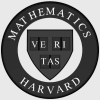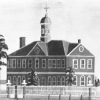
| Mathematics Department Timelines | 
|

| Mathematics Department Timelines | 
|
| 1636 | 8. September, the legislature of the Colony of Massachusetts Bay passed an act, which resulted in the foundation of Harvard College. (more details). |
| 1638 | "Mathematics has been taught at Harvard since 1638, when it was introduced as a direct inheritance from the English universities. In the 18th Century Professor John Winthrop (A.B. 1732) laid the foundation for the study of higher mathematics by definitely establishing instruction in the calculus. From 1831 to 1880 mathematics at Harvard was dominated by Benjamin Peirce (A.B. 1829), to whom is due the introduction on a lasting basis of the spirit of mathematical research. Present teaching emphasizes the sound reasoning which motivates, creates and gives life to the technical structure and which also furnishes a basis for the understanding of certain modern philosophical tendencies." Source: Cambridge, Massachusetts Harvard University Press, 1936 p. 43 |
| 1727 | Hollis Professorship of Mathematics and Natural Philosophy,
was founded. "The subject of mathematics has always been highly considered at Harvard. The first profesorship of a profane topic, the Hillis Professorship of Mathematics and Natural Philosophy, was founded in 1727. It is true that the choice of the first incumbent was not altogether a happy one, for if Isaac Greenwood (A.B. 1721) had the merit of orthodoxy, he had the failing of being a confirmed drunkard. The second professor John Wintrhop (A.B. 1732), appointed in 1738, more than restored the balance. He was Fellow of the Royhal Society, and the founder of American astronomy. During the years 1831-80 the strange figure of Benjamin Peirce (A.B. 1829) completely dominated the situation. His great natural mathematical talent and originality of thought, combined with a total inability to put anything clearly, produced opon his contemporaries a feeling of awe that amounted almost to dread. But his lasting effect on American mathematics was not commensuarte with his natural genious, and the same was perhaps true of J.J. Sylvester, professor of John Hopkins, and founder of the American Journal of Mathematics." Source: Julian Lowell Coolidge, Ph.D. Professor of Mathematics The Development of Harvard University, 1869-1929, Since the inauguration of President Eliot, 1869-1929 Chapter XV. Mathematics, 1870-1929 Edited by Samuel Eliot Morison, Cambridge, Massachusetts, Harvard University Press, 1930 Hollis, RR 1039.18 EducU 4810.10.30 |
| 30 May, 1737 | Rev. Edward Holyoke, Pastor of the church in Marblehead, was voted unanimously to be President of the seminary. |
| 29. September 1737 | Inauguration of President Holyoke. |
| 26. April 1737 | Mr. Isaac Greenwood, Hollisian Professor of Mathematics and Natural Philosophy was removed for "intemperance". The story is complicated but Quincy writes in the "History of Harvard university": "His views are somewhat in advance of the age in which he lived and, though in some respects imaginative, are both elevated and philosophical, and consonant with those persued years afterwards by Bishop Buthler with so much skill and renown in his 'Analogy of Religion to the Constitution and Course of Nature'. This discourse cannot be read without exciting emotions and sorrow and regret for the early ruin of a mind, which has left indications of possessing loftiness and capacity." |
| May 1806 | In May, 1806, John Pickering, Esq., was chosen Hancock Professor of Hebrew and other Oriental Languages, but he declined the appointment and in December, Sidney Williard, A.M. was elected, accepted the office, and, in February, 1807, entered on its duties. On the same day Nathaniel Bowditch, A.M. of Soalem, was appointed Hollis Professor of Mathematics and Natural Philosophy, and, he having declined the office, the Rev. Joseph McKean was chosen, who also declined. John Farrar, A.M. was then elected, and in June, 1807, formally inducted into the Professorship. |
| 1831 | The department of Mathematics and Natural Philosophy continued under the superindendence of Professor Farrar, until June 1831, when with the consent of the Corporation, he visited Europe for the restoration of his health; instruction in the mathematical branch of his department being transferred to the Tutor. |
| May 1833 | In May, 1833, the Corporation, with the assent of the Overseers, established a University Professorship of Mathematics and Natural Philosophy, to take the superintendence of all the instruction to Undergraduates, in various brances of pure Mathematics, to be conducted by hearing and criticizing recitations, or by oral communications or public lectures, as the Corporation might direct. Benjamin Peirce was then elected University professor on this foundation and has since fulfilled the duties of the office. Professor Farrar having about his time relinquished a third part of his salary, his labors were restricted, by consent of the Corporation, to lectures on Astronomy and Experimental Philosophy. |
| 1836 | In June, 1836, the health of Professor Farrar not having being permanently restored by his visit to Europe, he transmitted to the Corporation a resignation of his Professorship, which remained vacant until January, 1838, when Joseph Lovering, A.M., was elected Hollis Professor of Mathematics and Natural Philosophy, and entered on the duties of his office, which he continued to fulfil until 1888. |
| Source: Joshiah Quincy LL.D., President of the University "The History of Harvard University Volumes 1 and 2" Cambridge, Published by John Owen, 1840 |
| For a continuation of th story from 1836 on, see Birkhoffs booklet on the history of the Mathematics department from 1836-1944 and Coolige's article on the Development of Harvard University, 1870-1929. |
| This time period is discussed in this Notices of the AMS article by Steve Batterson. |
|
IMPORTANT DATES IN HARVARD HISTORY (Source) 1636 General Court votes �400 for "a schoale or colledge." 1637 Overseers appointed by the General Court "to take order for a colledge." First master appointed; site purchased. 1638 College opened on the present site. Death and legacy of John Harvard. 1639 Named Harvard College by the General Court. 1640 Dunster elected president. 1642 First Commencement. Organic Act of the Board of Overseers. 1643 First scholarship fund established (Mowlson-Bridges donation). 1650 President and Fellows of Harvard College incorporated by the General Court. 1686 Charter of 1650 in abeyance. 1692 First degrees in divinity conferred. 1707 Charter of 1650 restored. 1721 First endowed chair established. 1773 First doctorate of laws conferred. 1775 College removed to Concord. College buildings used by the Continental Army during the siege of Boston. 1776 College returned to Cambridge. 1782 First professorships in medicine established. 1788 First degrees in medicine conferred. 1807 Botanic Garden founded. 1810 Medical School removed to Boston. 1816 A theological seminary (later the Divinity School) organized. 1817 Law School established. 1819 Faculty of Theology instituted. 1825 Ticknor reforms; beginning of Departments; Faculty of Arts first so called. 1843 Astronomical Observatory founded by subscription. 1847 Lawrence Scientific School established. 1859 Museum of Comparative Zoology founded. 1866 Peabody Museum of Archaeology and Ethnology founded. 1867 Dental School established. 1871 Summer courses of instruction first offered. 1872 Arnold Arboretum founded. 1872 Graduate Department, now the Graduate School of Arts and Sciences, established. 1879 Cryptogamic Collection, later the Farlow Library and Herbarium, accepted by the University. 1885 Blue Hill Meterological Observatory organized. 1889 Semitic Museum founded. 1890 Faculty of Arts and Sciences reorganized. 1891 Southern station of the Astronomical Observatory organized at Arequipa, Peru. 1894 William Hayes Fogg Art Museum founded. 1902 Germanic Museum organized. 1905 Name of the Graduate School changed to Graduate School of Arts and Sciences. 1906 Lawrence Scientific School discontinued; instruction in engineering given in the Graduate School of Applied Science under the Faculty 1906 Lawrence Scientific School discontinued; instruction in engineering given in the Graduate School of Applied Science under the Faculty of Arts and Sciences. 1907 Harvard Forest acquired. 1908 Graduate School of Business Administration organized under the Faculty of Arts and Sciences. 1909 Harvard Cancer Commission organized. 1910 Administrative Board for University Extension first instituted. 1911 Graduate School of Medicine organized under the Faculty of Medicine. 1911 First degrees in Public Health conferred. 1912-14 Graduate School of Applied Science replaced by Graduate Schools of Applied Science under a separate faculty. 1912 Collis P. Huntington Memorial Hospital founded. 1913 Graduate School of Business Administration established as a separate department of the University. 1913 Joint "Harvard-Technology" School of Public Health organized. 1913 Harvard University Press organized. 1914 Faculty of Architecture instituted as a separate faculty. 1914 School of Landscape Architecture established as a separate school tinder the Faculty of Architecture. 1914-17 Engineering instruction administered jointly by Harvard University and the Massachusetts Institute of Technology. 1918 Faculty of Engineering re-instituted within the University; Harvard Engineering School opened to undergraduate and graduate students. 1919 Instruction given under the Graduate School of Medicine reorganized as "Courses for Graduates." 1919 Atkins Fund for Tropical Research in Economic Botany, endowing the Harvard Experiment Station in Cuba (later the Atkins Institution of the Arnold Arboretum), accepted by the University. 1920 Graduate School of Education established. 1922 Harvard School of Public Health established. 1927 Southern Station of the Astronomical Observatory transferred to Bloemfontein, South Africa. 1928 Harvard-Yenching Institute founded. 1929 School of City Planning established as a separate school under the Faculty of Architecture. 1930 First residential Houses opened. 1932 Society of Fellows founded. 1935 Graduate School of Engineering established; undergraduate students of engineering sciences enrolled in Harvard College. 1935 Graduate School of Public Administration endowed. 1936 Faculty of Design instituted to replace Faculty of Architecture, administering instruction and research in the Departments of Architecture, Landscape Architecture, and Regional Planning. CHRONOLOGICAL TABLES PRESIDENTS Entered Presidents Left Office -------------------------- 1640, Aug. 27 HENRY DUNSTER Oct. 24, 1654 1654, Nov. 27 CHARLES CHAUNCY Feb. 19, 1672 * 1672, Oct. 1 LEONARD HOAR Mar. 15, 1674 1675, Apr. 19 URIAN OAKES Jul. 25, 1681 * 1682, Oct. 25 JOHN ROGERS Jul. 2, 1684 1685, Jun. 11 INCREASE MATHER Sep. 6, 1701 ** 1708, Jan. 14 JOHN LEVERETT May. 3, 1724 * 1725, Jun. 8 BENJAMIN WADSWORTH Mar. 16, 1737 * 1737, Sep. 21 EDWARD HOLYOKE Jun 1, 1769 * 1770, Mar. 21 SAMUEL LOCKE Dec. 1, 1773 1774, Oct. 14 SAMUEL LANGDON Aug. 30, 1780 1781, Dec. 19 JOSEPH WiLLARD Sep. 25, 1804 * 1806, May. 6 SAMUEL WEBBER Jul. 17, 1810 * 1810, Nov. 14 JOHN THORNTON KIRKLAND Apr. 2, 1828 1829, Jan. 29 JOSIAH QUINCY Aug. 27, 1845 1846, Feb. 5 EDWARD EVERETT Feb. 1, 1849 1849, Feb. 1 JARED SPARKS Feb. I0, 1853 1853, Feb. 10 JAMES WALKER Jan. 26, 1860 1860, Feb. 16 CORNELIUS CONWAY FELTON Feb. 26, 1862 * 1862, Oct. 6 THOMAS HILL Sep. 30, 1868 1869, May. 19 CHARLES WILLIAM ELIOT May. 19, 1909 1909, May. 19 ABBOTT LAWRENCE LOWELL Sep. 1, 1933 1933, Sep. 1 JAMES BRYANT CONANT * Died in office. ** His title was Rector from July 23, 1684, to 1689 or 1690. |
| Last update: 6/26/2006 | Back to the department homepage |